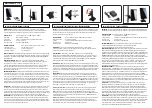
28
INSTALLING EXTERIOR CABLES AND CONNECTING TO GROUND BLOCK
INSTALLATION PROCEDURE
This section describes routing and installing the coaxial cable
between the low-noise block (LNB) and the ground block. You
may have to bury the coaxial cable, particularly if you use a
metal pole install. Use only quality burial specified cables.
When normal coaxial cable is buried, its useful life is short-
ened. The outer cover decays in the soil, absorbs moisture, and
corrodes. Cables suitable for burial use a special outer cover
that resists breakdown. Some of these cables use flooded gel
and treated shields. This coating resists corrosion if water gets
into the cable. Use only quality burial specified cables. This
will help prevent problems in the future.
An important goal of your cable installation is to protect the
cable from physical damage and moisture penetration. To pro-
tect the cable from physical damage, secure it to walls or other
stable surfaces with cable clips. This prevents the cable from
sagging and being damaged by people stepping on it or running
over it with yard equipment. Prevent moisture penetration by
using weatherproof connectors, and by sealing any connection
that is exposed to the elements. Drip loops provide a connec-
tion with additional protection by preventing moisture from
traveling down the cable and entering the connection.
Note: if you do not use RG6 quad shielded cable (CommScope 5781
or equivalent) you must run a ground wire from the mast base plate to
the ground block (see page 31) and install it and the ground block
ground wire onto a split bolt and clamp nut.
1. Determine where you will install the ground block. It must
be near where the coaxial cable enters the building. Plan a
short and straight path for the ground wire from the ground
block to the grounding scheme.
2. Secure the ground block to a stable mounting surface with
two screws (see Figure 36).
3. Connect one end of the 14 AWG copper/ 8AWG aluminum
ground wire to the ground terminal of the ground block.
4. Connect the other end of the ground wire to the grounding
scheme. If necessary, secure the ground wire with cable ties
or insulated U-shaped tacks.
5. Select a length of cable that can be routed easily between
the LNB on the feed assembly and the ground block.
6. Connect the coaxial cable to the ground block (see
Figure 37). Form a drip loop and secure the cable with cable
clips. A drip loop 2 or 3 inches in diameter is large enough;
the diameter can be no more than 14 inches.
7. Connect the interior cable (coming out of the access hole in
the wall) to the opposite side of the ground block (see
Figure 36). Form a drip loop and secure with cable clips.
8. Tighten the cable connections with a wrench.
PARTS NEEDED
TOOLS NEEDED
• Type RG-6 coaxial cable
• 14 AWG copper/ 8 AWG ground wire
• F-type dual ground block and screws
• Cable ties or U-shaped tacks
• If needed, split bolt and clamp
nut
• Flat-blade screwdriver
• Hammer
• 14/8 AWG wire cutters
CAUTION
• Verify before you drill that there are no pipes in the wall
near where you will be drilling.
• Damaging pipes may cause property damage.
WARNING
• Verify before you drill that there are no electrical wires
in the wall near where you will be drilling.
• You may be killed or seriously injured if you contact wir-
ing while drilling.
Figure 36
Figure 37
Into building
To antenna
Sealant
Grounding wire
Drip loop
Cable
clips
Ground
block
Ground block
Coaxial cable(s)
(only one cable
for single LNBs)
Grounding wire
G-22830 F













































